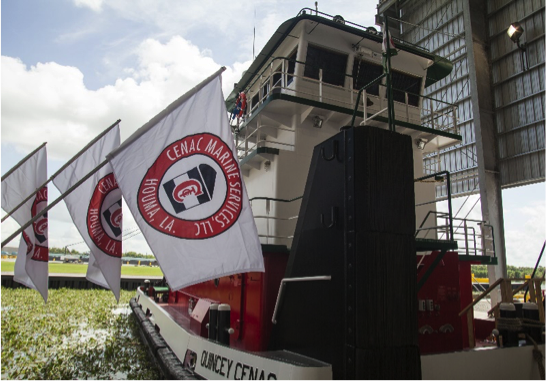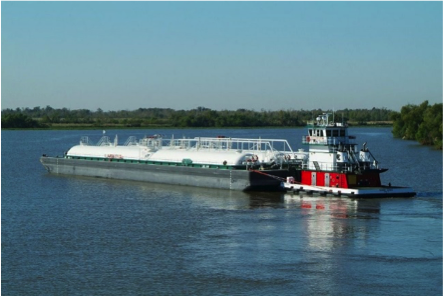Benny Cenac of Houma and the history of tugboats

Sponsored Content
By Cenac Marine Services
Arlen “Benny” Cenac looks out the window of his Main Iron Works office to see another barge being towed by a majestic, shining tugboat along the Mississippi River channel that buttresses his shipyard. The barge might have been filled with tanks of crude oil or cargo—bringing supplies down the Mississippi River to the Gulf of Mexico, then beyond, to far-away places like Mexico, the Bahamas, even coastal countries in Asia and Africa. But for Cenac, tugboats and maritime work anchor him to his Cajun community—and propel his family business towards the future.
For over 150 years, tugboats have been a significant form of maritime transportation. These small, powerful watercrafts maneuver larger ships in tight areas, and tow unpowered vessels to various ports. In 1736, Englishman Jonathan Hulls patented a boat powered by a Newcomen steam engine to move large vessels in and out of ports and harbors. Technically, the first tugboat ever built was the Scottish Charlotte Dundas, powered by a Watt engine and the ever-popular paddle wheel, in the Forth and Clyde Canal. The early 19th century ushered in an era of screw propelled-tugboats in the United States, predating the diesel engine created about a half-century later. By the early 1800’s, riverboats were being fitted with steam engines—the most efficient and widespread way to propel boats, especially in the era of the Industrial Revolution, the Machine Age, and a rapid period of growth for worldwide economies and innovation.
Tugboats were initially used for passenger carry but people quickly realized the potential and profitability for towing. Within a decade, ports around the globe employed towing operators to assist ships in and out of harbors, rivers and canals. By the mid 1800’s, huge amounts of freight was being transported on waterways—soon exporters, importers, and maritime executives built barges just for materials. Ship engineers and builders experimented with various forms of propulsion; the first tugboats were powered with fairly simple, reliable, and powerful steam engines. The wood and coal burned into steam were relatively cheap and abundant. By the early 1900s, gasoline and diesel engines soon replaced steam. The newfangled, smaller internal combustion engines offered an instant and more efficient start to the boat, while the traditional steam engine required several hours for the steam boiler to make enough steam to run the engine. Modern tugboats maneuver other vessels using a tow line, but before the early 20th century, teams of mules and horses were the standard towing method for the canal boats. In the old days, tug captains often relied on their steam whistles to notify a lock tender of their arrival down the canal, although most times the lock tender caught them travelling at a slow speed and readied the lock.
Most tugboats in the 19th and early 20th century relied on screw propellers, held in shrouds to increase thrust and to improve their ability to change direction and navigate. The bottom of the hull slopes up to provide a steady stream of water to the propellers. Men on tugs with screw propellers witnessed how much more power metal blades provided than paddlewheels; thanks to the rise of the manufacturing era, iron and steel hulls became more common. Companies and boatbuilders started crafting larger vessels to adopt to the newer, larger propellers—and crews expanded into ocean salvage work and transport, instead of solely relying on canals and smaller waterways. But the invention of the diesel engine forever changed the towboat trajectory. Diesel was lighter and cheaper to run, and the boat costs were slashed now that fewer crewmembers were needed to man the ship and its many engine systems. Steam-powered tugs traveled up and down the Mississippi River until the 1950’s, when most boats had been converted to diesel.
Today’s Tugs: Benny Cenac, Houma Business Owner and Mariner, Describes 21st Century Tugboats

Today’s tugboats typically have firefighting monitors, allowing them to assist in firefighting should one arise in a crowded area like a harbor. There are four basic categories of ocean or seagoing tugs: the standard tug reliant on a wire cable or rope hawser, the “notch tug” or combination ship usually built with a towing winch, the “integral tug and barge” (ITB) that locks together certain vessels, or the “articulate tug and barge” (ATB) units that slips into a notch in the stern and connects with a hinge.
A tugboat is typically rated by its engine’s power output and its overall bollard pull. Today’s largest tugboats have approximately 60 to 65 short tons-force (530–580 kN) of bollard pull, or 15 short tons-force (130 kN) above “normal” tugboats. An average tug boat has an engine of 680-3400 hp (500-2500 kW) but boats sent out to deep ocean waters have engines powered by nine-times as much horsepower or 27200 hp (20000 kW)! Modern tugs are beasts—running off ten thousand horsepower and carrying upwards of hundred thousand gallons of fuel. Most cargo ships spend their time tracing latitudinal lines, going up to five thousand miles without changing course. The ship building industry is seeing more and more behemoths built these days—some ships are over a thousand feet long with as much cargo room as 11,000 trucks. Larger ships lead to fewer but more powerful tugs to tow the same barges, but turnarounds are faster than ever. Tugs that once docked at port for a week or so now have turnarounds of less than twenty-four hours. Break-bulk cargo, previously laboriously sorted onshore, has given way to uniform steel containers, transferred to truck or train by crane or conveyor belt.
Nowadays, as few as two or three tugboats can maneuver even the largest of ships in and out of a harbor. New approaches to towing barges developed during and after World War II have allowed effective towing to the open seas, and now tug and barge operations can carry massive loads at cheaper rates to compete with other cargo ships. By the late 1940’s, the tugboat business expanded tremendously thanks to new upgrades in ship design, propulsion technology, communication and navigation equipment. At Benny Cenac’s Houma maritime businesses – Houma Machine and Propeller, Main Iron Works, Cenac Marine – he and his crew build ever-evolving, bigger, stronger ships used for the various river, harbor, and ocean work. Cenac’s Houma business also tends to the older, still-well-built tugs of the past and upgrade and refits them with modern equipment and technologies to ensure fast, safe, and efficient processes on waterways today and tomorrow.




